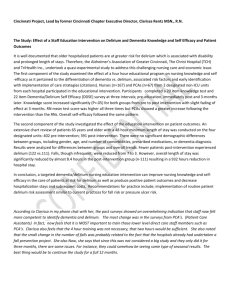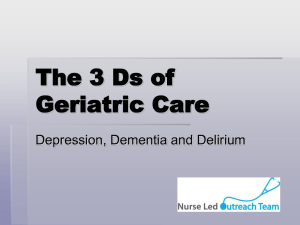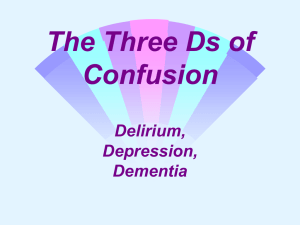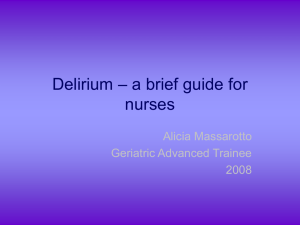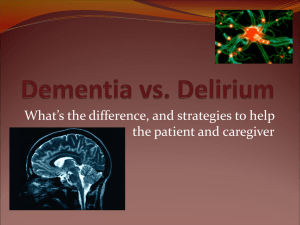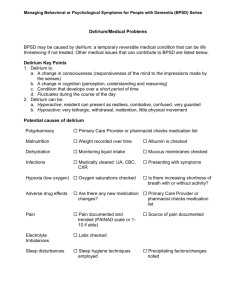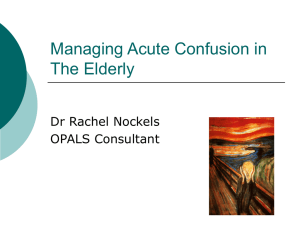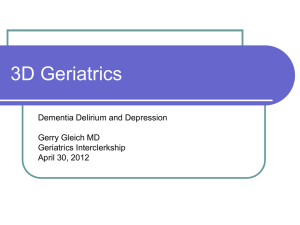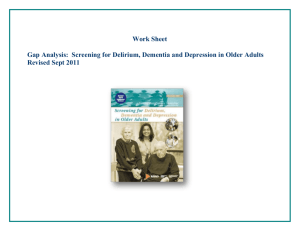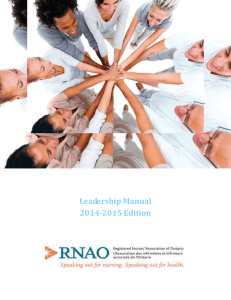Gap Analysis for Screening Delirium, Dementia and Depression
advertisement
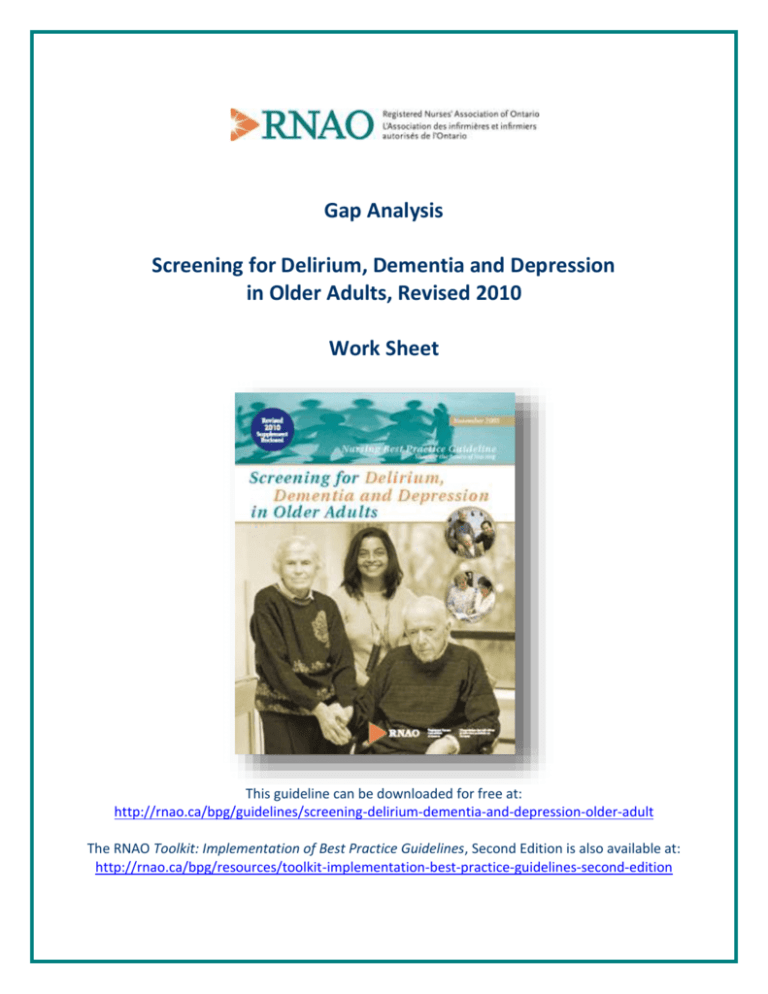
Gap Analysis Screening for Delirium, Dementia and Depression in Older Adults, Revised 2010 Work Sheet This guideline can be downloaded for free at: http://rnao.ca/bpg/guidelines/screening-delirium-dementia-and-depression-older-adult The RNAO Toolkit: Implementation of Best Practice Guidelines, Second Edition is also available at: http://rnao.ca/bpg/resources/toolkit-implementation-best-practice-guidelines-second-edition What is a Gap Analysis? Uses of a Gap Analysis A process comparing your organization’s current practice with evidence-based best practice recommendations to determine: Existing practices and processes that are currently implemented and supported by best practices. This information is useful to reinforce practice strengths. Recommendations that are currently partially implemented in practice. These would be good first targets for change efforts. Recommendations that are not currently being met. Recommendations that are not applicable to your practice setting. Contributes to annual evaluation by allowing you to compare practice from year to year and choose which areas to focus on changing within the year. Focuses on needed practice change which prevents a total overhaul of practice and builds on established practices and processes. Informs next steps such as development of infrastructure to support implementation, stakeholder engagement, identification of barriers and facilitators, resource requirements, selection of implementation strategies and evaluation approaches. Leads to sustained practice change by informing plans related to process, staff and organization and reinforces current evidence based practices. Conducting a Gap Analysis Engage the team, and internal and external stakeholders as needed in gathering information for the gap analysis. Collect information on: Current practice – is it known and is it consistent? Are there any barriers to implementation? These (met, unmet, partially met) may include staffing, skill mix, budget, workload issues, etc. Partially met recommendations may only be implemented in some parts of the home, or you What are the time frames in relation to specific may feel it is only half done. actions and people or departments who can support the change effort? Are there some recommendations that must be implemented before others? Are there links with other practices and programs in the LTC home? Can any recommendations be implemented quickly? These are easy wins and build confidence Are there existing resources and education that in the change. your LTC home can access? Are there recommendations based on higher levels Are there any must-do recommendations that are of evidence than others? crucial to resident and staff safety? Next Steps What does Strength of Evidence mean? 1. Celebrate the recommendations you are meeting. 2. Prioritize the areas you want to work on. Start with practice changes that can be made easily or are crucial to resident and staff safety. Start by reinforcing success and focusing on quick wins. 3. These priority areas become the foundation for planning your program or implementing practice change. 4. For more information on taking your gap analysis to the next level see the RNAO Toolkit: Implementation of Best Practice Guidelines (Second edition). After each guideline recommendation you will notice a ‘strength of evidence’. Strength of evidence is a ranking system used to describe the strength of results measured in clinical trials and other types of research studies. Strength of Evidence A: Requires at least two randomized controlled trials as part of the body of literature of overall quality and consistency addressing the specific recommendations. Long-Term Care Homes: Contact your Long-Term Care Best Practice Co-ordinator to assist you in completing a gap analysis. Visit RNAO.ca/ltc. Gap Analysis – Updated September 2013 Strength of Evidence B: Requires availability of well conducted clinical studies, but no randomized controlled trials on the topic of recommendations. Strength of Evidence C: Requires evidence from expert committee reports or opinions and/or clinical experience of respected authorities. Indicates absence of directly applicable studies of good quality Page 2 of 6 Gap Analysis Work Sheet - Screening for Delirium, Dementia and Depression in Older Adults, Revised 2010 Date Completed: Team Members participating in the Gap Analysis: Unmet Partially Met RNAO Best Practice Guideline Recommendations Met Completion of this gap analysis allows for the annual comparison of your current practice to evidence-based practices as regulated by the MOHLTC. See Appendix A for this and other regulations that apply to a responsive behaviour program in your home. Notes (Examples of what to include: is this a priority to our home, information on current practice, possible overlap with other programs or partners) Practice Recommendations 1. Nurses should maintain a high index of suspicion for delirium, dementia and depression in the older adult. (Strength of Evidence = B) 2. Nurses screen clients for changes in cognition, function, behaviour, and/or mood based on their ongoing observations of the client and/or concerns expressed by the client, family and/or interdisciplinary team including other specialty physicians. (Strength of Evidence = C) 3. Nurses must recognize that delirium, dementia and depression present with overlapping clinical features and may co-exist in the older adult. (Strength of Evidence = B) 4. Nurses should be aware of the differences in the clinical features of delirium, dementia and depression and use a structured assessment method to facilitate this process. (Strength of Evidence = C) 5. Nurses should objectively assess for cognitive changes by using one or more standardized tools in order to substantiate clinical observations. (Strength of Evidence = A) 6. Factors such as sensory impairment and physical disability should be assessed and considered in the selection of mental status tests. (Strength of Evidence = B) 7. When the nurse determines the client is exhibiting features of delirium, dementia and/or depression, a referral for a medical diagnosis should be made to specialized geriatric services, specialized geriatric psychiatry services, neurologists, and/or members of the Gap Analysis – Updated September 2013 Page 3 of 6 Unmet Partially Met Met Gap Analysis Work Sheet - Screening for Delirium, Dementia and Depression in Older Adults, Revised 2010 Notes RNAO Best Practice Guideline (Examples of what to include: is this a priority to our home, information on current practice, possible overlap with Recommendations other programs or partners) multidisciplinary team, as indicated by screening findings. (Strength of Evidence = C) 8. Nurses should screen for suicidal ideation and intent when a high index of suspicion for depression is present, and seek an urgent medical referral. Further, should the nurse have a high index of suspicion for delirium, an urgent referral is recommended. (Strength of Evidence = C) Education Recommendations 9. All entry-level nursing programs should include specialized content about the older adult, such as normal aging, screening assessment, and caregiving strategies for delirium, dementia, and depression. Nursing students should be provided with opportunities to care for older adults. (Strength of Evidence = C) 10. Organizations should consider screening assessments of the older adult’s mental health status as integral to nursing practice. Integration of a variety of professional development opportunities to support nurses in effectively developing skills in assessing the individual for delirium, dementia and depression, is recommended. These opportunities will vary depending on model of care and practice setting. (Strength of Evidence = C) Organization and Policy Recommendations 11. Nursing best practice guidelines can be successfully implemented only where there are adequate planning, resources, organizational and administrative support, as well as appropriate facilitation. Organizations may wish to develop a plan for implementation that includes: An assessment of organizational readiness and barriers to implementation. Involvement of all members (whether in a direct or indirect supportive function) who will contribute to the implementation process. Dedication of a qualified individual to provide the support needed for the education and implementation process. Gap Analysis – Updated September 2013 Page 4 of 6 Unmet Partially Met Met Gap Analysis Work Sheet - Screening for Delirium, Dementia and Depression in Older Adults, Revised 2010 Notes RNAO Best Practice Guideline (Examples of what to include: is this a priority to our home, information on current practice, possible overlap with Recommendations other programs or partners) Ongoing opportunities for discussion and education to reinforce the importance of best practices. Opportunities for reflection on personal and organizational experience in implementing guidelines. In this regard, RNAO (through a panel of nurses, researchers and administrators) has developed the “Toolkit: Implementation of clinical practice guidelines”, based on available evidence, theoretical perspectives and consensus. The RNAO strongly recommends the use of this Toolkit for guiding the implementation of the best practice guideline on Screening for Delirium, Dementia and Depression in Older Adults. (Strength of Evidence = C) Gap Analysis – Updated September 2013 Page 5 of 6 Gap Analysis Work Sheet - Screening for Delirium, Dementia and Depression in Older Adults, Revised 2010 Appendix A Applicable Ministry of Health and Long-Term Care Regulations for Responsive Behaviours 53. (1) Every licensee of a long-term care home shall ensure that the following are developed to meet the needs of residents with responsive behaviours: 1. Written approaches to care, including screening protocols, assessment, reassessment and identification of behavioural triggers that may result in responsive behaviours, whether cognitive, physical, emotional, social, environmental or other. 2. Written strategies, including techniques and interventions, to prevent, minimize or respond to the responsive behaviours. 3. Resident monitoring and internal reporting protocols. 4. Protocols for the referral of residents to specialized resources where required. O. Reg. 79/10, s. 53 (1). (2) The licensee shall ensure that, for all programs and services, the matters referred to in subsection (1) are, (a) integrated into the care that is provided to all residents; (b) based on the assessed needs of residents with responsive behaviours; and (c) co-ordinated and implemented on an interdisciplinary basis. O. Reg. 79/10, s. 53 (2). (3) The licensee shall ensure that, (a) the matters referred to in subsection (1) are developed and implemented in accordance with evidence-based practices and, if there are none, in accordance with prevailing practices; (b) at least annually, the matters referred to in subsection (1) are evaluated and updated in accordance with evidence-based practices and, if there are none, in accordance with prevailing practices; and (c) a written record is kept relating to each evaluation under clause (b) that includes the date of the evaluation, the names of the persons who participated in the evaluation, a summary of the changes made and the date that those changes were implemented. O. Reg. 79/10, s. 53 (3). (4) The licensee shall ensure that, for each resident demonstrating responsive behaviours, (a) the behavioural triggers for the resident are identified, where possible; (b) strategies are developed and implemented to respond to these behaviours, where possible; and (c) actions are taken to respond to the needs of the resident, including assessments, reassessments and interventions and that the resident’s responses to interventions are documented. O. Reg. 79/10, s. 53 (4). Gap Analysis – Updated September 2013 Page 6 of 6
